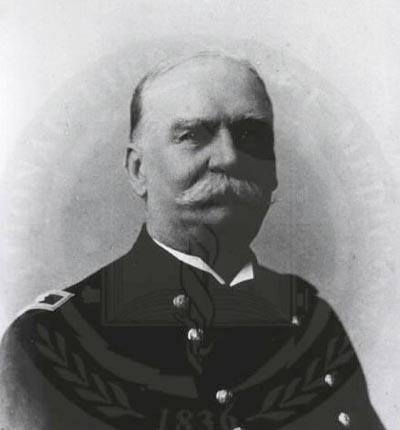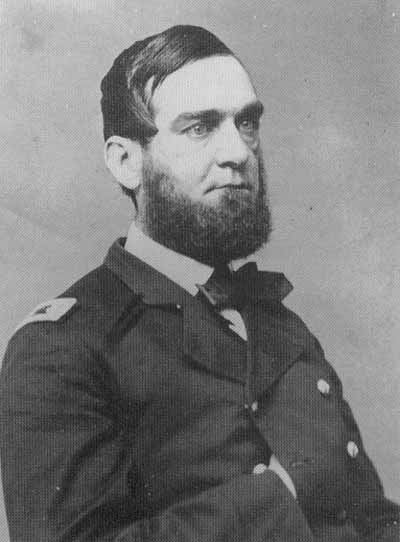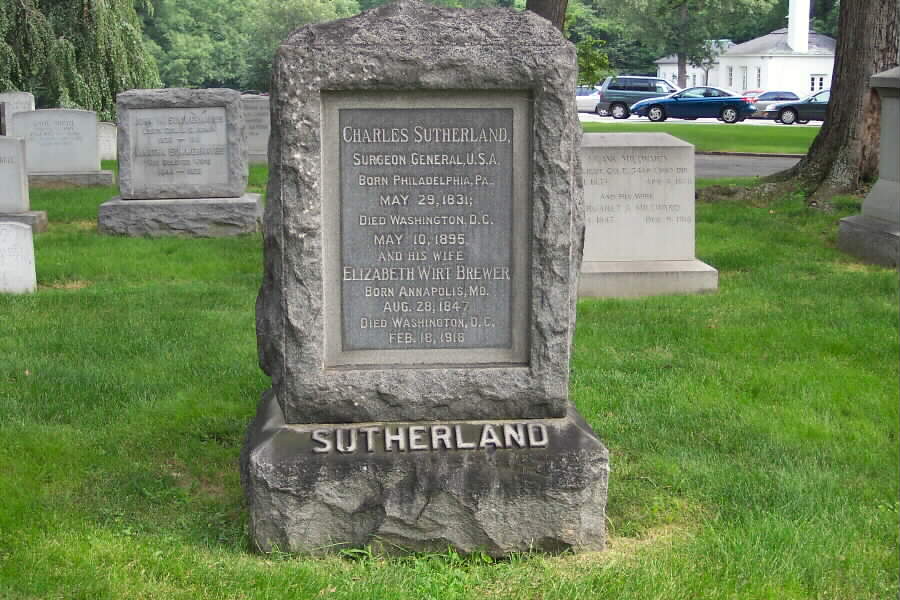From a contemporary press report:
May 29,1829 – May 10, 1895
Charles Sutherland, Surgeon General of the Army, December 23, 1890 – May 29, 1893, was born in Philadelphia, the son of Joel Barlow and Mary (Read) Sutherland, of Scotch ancestry. His father, a graduate of the University of Pennsylvania Medical School, served in the War of 1812, first as an Assistant Surgeon and later as Lieutenant colonel of an Infantry regiment. Later he studied law, became a member of the state legislature, a member of Congress (1825-1837), and still later judge of the court of common pleas in Philadelphia. He was the first president of the Society of the War of 1812, of which Society General Sutherland himself was at one time the historian.
The son received the best educational advantages afforded by the private schools of Philadelphia and his medical education at Jefferson Medical College where he was graduated in 1849. He passed the examination for the medical corps of the army in 1851 and after ten months of service as an acting assistant surgeon he was commissioned as assistant surgeon on August 5, 1852. His first stations were Fortress Monroe and Jefferson Barracks. At the latter post he bad the experience of an outbreak of cholera among the troops.
From this post he went with an exploring party which located the site for Fort Riley in Kansas and developed a shorter route for the overland trail to Santa Fe, New Mexico. He remained in New Mexico for the next five years, serving for various periods at Forts Webster, Fillmore, Craig, Stanton, and Santa Fe, and participating in much field service against the Apache and Comanche Indians.
In October 1859 he went to Fort Moultrie, South Carolina, where he remained for a year, after which he was ordered to Texas where he served at Forts Davis and Duncan on the Mexican border. He was on this duty when the Civil War broke out. The garrison with which he was serving succeeded in avoiding capture by the Confederate forces and secured boat transportation to New York. Reporting to the War Department he was sent with a force to reinforce the garrison holding Fort Pickens in Florida. During his year of service at this post it was subjected to two bombardments and an assault by Confederate forces from Forts Barrancas and McRee, the other defenses of Pensacola harbor which had been captured by the Confederate arms.
For his efficiency in handling the medical service in these engagements Sutherland received special commendation from General Harvey Brown, commanding the fort. He was promoted to the grade of major and surgeon on April 16, 1862, and at about the same time assigned to duty at Fort Warren, Massachusetts, then a prison camp for the captured Confederate officers who were held there to the number of several hundred.
In June 1862 he was ordered to report to General Halleck at Corinth, Mississippi, and assigned to duty as medical purveyor for the armies concentrated in that center of military activity. In the pursuance of this duty he established a medical depot at Columbus, Kentucky, with supplies for the two hundred thousand men whom it was estimated would make up General Halleck’s armies. A second large depot was organized at Memphis, Tenn., where he fitted out nine general hospitals with a capacity of three thousand beds for the casualties among the troops along the Mississippi and equipped a floating hospital of eight hundred beds for use at Milliken’s Bend near Vicksburg, then under siege by General Grant. He was with the headquarters of Grant’s army before Vicksburg for some months, serving as assistant medical director and inspector of camps and hospitals of the Army of the Tennessee. His duties consisted in the sanitary inspection of camps, transfer of wounded to transports for northern hospitals, and the supply of medicine and hospital stores. He participated in the battles of Jackson and Champion Hills, having general supervision of the field hospitals established for these engagements.
After the fall of Vicksburg he was transferred east to the position of medical director of the Department of Virginia in North Carolina under General John G. Foster, and later in the same year to Annapolis, Maryland, as medical director of hospitals and parole camp. In May 1864 be was ordered to Washington and assigned as medical purveyor for the Army of the Potomac and for the hospitals in and around Washington. He served to the end of the war on this duty which involved the supply of one hundred and fifty thousand men in the field and of twenty hospitals with a bed capacity of thirty thousand patients. For such a service large warehouses were required, with a large force of workmen to handle the flow of incoming and outgoing supplies.
During Sutherland’s incumbency of this office he disbursed over four million dollars without loss or question.
With the reorganization of the army at the close of the Civil War, Sutherland had the backing of Surgeon General Barnes and of General Grant for one of the positions of medical purveyor which was given him with the grade of lieutenant colonel on July 28, 1866. For the next thirteen years he divided his time between the New York and Washington medical purveying depots, meanwhile receiving the promotion to the grade of colonel on June 26, 1876. From 1879 to 1884 he served as medical director of the Division of the Pacific at San Francisco and from 1884 until his appointment as Surgeon General, as medical director of the Division of the Atlantic at New York.
Following the death of Surgeon General Baxter in December 1890, there were the usual number of candidates for the vacated place but President Harrison followed the precedent broken only in recent years by the selection of General Moore and appointed the senior officer in the person of Colonel Sutherland to be Surgeon General on December 23, 1890. Major Pilcher describes his administration as being “conservative and progressive,” which can be interpreted that General Sutherland’s office was as progressive as the conservative temper of the War Department of his day would allow.
With a continuing interest in medical supply he gave the medical department a new field equipment but deprived the medical officer of a personal equipment which he had formerly been issued. The organization of the enlisted medical personnel into detachments began about this time and it was during General Sutherland’s term, in 1891, that Captain (later Colonel) John Van R. Hoff organized the first company of instruction for the Hospital Corps at Fort Riley, Kansas. Captain Hoff applied the term Hospital Corps to these enlisted men but the name was not officially authorized until 1901.
General Sutherland was a large and powerful man, standing over six feet two inches and of corresponding bulk. He was of a kind and amiable disposition, a good friend and an attractive companion. He was highly popular with the junior officers of the corps. He was retired by reason of reaching the age limit on May 29, 1893. He continued to make his home in Washington where he died suddenly of angina pectoris on May 10, 1895, in his sixty-sixth year.
He was married on November 3, 1869, in Montgomery County, Maryland, to Elizabeth Wirt Brewer, who with seven children survived him. He had been previously married to Kate Brewer who died in November 1866.
The General and his wife, Elizabeth Wirt Brewer Sutherland, born at Annapolis, Maryland, 28 August 1847 and who died at Washington, D.C., 18 February 1918, along with serveral of their children (see below) are buried in Section 1 of Arlington National Cemetery.
MISS SUTHERLAND POISONED
Laudanum Kills Daughter of the Late Surgeon General
WASHINGTON, May 2, 1904 – Miss Edith Sutherland, the eldest daughter of the late Surgeon General Charles Sutherland of the Army, is dead here from the effects of laudanum poisonig.
Since the death o her father, eight years ago, Miss. Sutherland had helped to support the family, but her health failed, and for several years she suffered from dispondency. Miss Sutherland was thirty-two years of age. The Coroner gave a certificate of death from melancholia and opium poisoning.
SUTHERLAND, AGNES D/O CHARLES
DATE OF DEATH: 07/03/1942
DATE OF INTERMENT: 07/06/1942
BURIED AT: SECTION WEST SITE 152-B
ARLINGTON NATIONAL CEMETERY
DAUGHTER OF CHARLES SUTHERLAND – BRIG GEN USA
SUTHERLAND, CATHERINE D/O CHARLES
DATE OF BIRTH: 08/18/1878
DATE OF DEATH: 03/12/1959
DATE OF INTERMENT: 10/17/1960
BURIED AT: SECTION 1 SITE 152
ARLINGTON NATIONAL CEMETERY
DAUGHTER OF CHARLES UTHERLAND – B/GEN USA
SUTHERLAND, CHAS
BRIG GEN USA
VETERAN SERVICE DATES: Unknown
DATE OF DEATH: 05/10/1895
DATE OF INTERMENT: Unknown
BURIED AT: SITE 152
ARLINGTON NATIONAL CEMETERY
SUTHERLAND, DOUGLAS MARTIN
CAPT QMC
VETERAN SERVICE DATES: Unknown
DATE OF DEATH: 09/14/1921
DATE OF INTERMENT: 09/16/1921
BURIED AT: SITE B-152
ARLINGTON NATIONAL CEMETERY
SUTHERLAND, ELIZABETH W W/O CHARLES
DATE OF DEATH: 02/18/1918
DATE OF INTERMENT: Unknown
BURIED AT: SECTION A&B SITE 152
ARLINGTON NATIONAL CEMETERY
WIFE OF CHARLES SUTHERLAND – BRIG GEN USA
SUTHERLAND, LUCY D/O CHARLES
DATE OF DEATH: 08/07/1949
DATE OF INTERMENT: 08/10/1949
BURIED AT: SECTION 1 SITE 152-A&B
ARLINGTON NATIONAL CEMETERY
DAUGHTER OF CHARLES SUTHERLAND – SURGEON GEN U S A
SUTHERLAND, ROY S/O
DATE OF DEATH: 06/12/1897
DATE OF INTERMENT: Unknown
BURIED AT: SITE 152
ARLINGTON NATIONAL CEMETERY
SON OF CHARLES SUTHERLAND – SURGEON GEN
SUTHERLAND, EDITH D/O CHAS
BURIED AT: SECTION S SID SITE 10
ARLINGTON NATIONAL CEMETERY
Photos Courtesy of the United States Army
Michael Robert Patterson was born in Arlington and is the son of a former officer of the US Army. So it was no wonder that sooner or later his interests drew him to American history and especially to American military history. Many of his articles can be found on renowned portals like the New York Times, Washingtonpost or Wikipedia.
Reviewed by: Michael Howard



